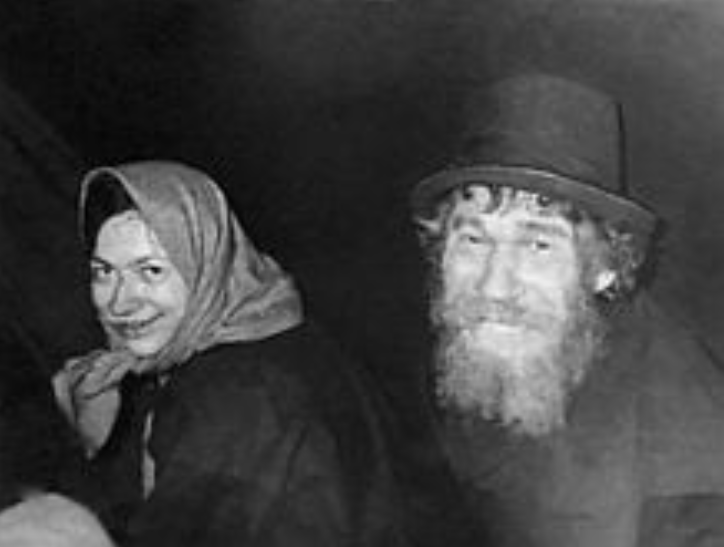In the summer of 1978, a pilot of the Russian SSR tried in vain to touch down on the remote slopes of Russia’s unique wilderness. Though his mission was to transport a group of Soviet geologists to aid in their search for iron ore, he soon found himself entangled in a story much larger than he could have imagined, one that would become a national sensation behind the massive Iron Curtain.
He discovered the Lykov family that had been missing for over half a century, living so far from civilization that they were unaware the Second World War had even occurred.
It was a shock to the pilot to discover that this desolate forest, with the nearest signs of human habitation 150 miles away, was home to a family. The geologists, equally astounded by this unexpected find, decided to land and delve deeper into this mystery.

The Abakan district’s Siberian taiga. For over 40 years, six members of the Lykov family lived in this secluded wilderness, more than 150 miles from the closest human town.
Siberian summers are fleeting. Snow clings to the landscape well into May, and by September, the cold returns, freezing the taiga into a stark, breathtaking tableau: miles of scraggly pine and birch forests, home to hibernating bears and prowling wolves; steep mountains; white-water rivers cascading through valleys; and a vast expanse of icy bogs. This forest is Earth’s final and greatest wilderness, stretching from the Arctic regions of Russia south to Mongolia and from the Urals to the Pacific—a staggering five million square miles of emptiness, with only a few thousand people living outside a handful of towns.
The taiga blooms when the brief warm days arrive, transforming into an almost welcoming landscape for a few short months. During this time, man can glimpse this hidden world most clearly—not by land, for the taiga can swallow entire armies of explorers, but from the air. Siberia, the source of much of Russia’s oil and mineral wealth, has seen even its most remote parts overflown by oil prospectors and surveyors on their way to isolated camps where the extraction of resources continues.
The First Contact with the Lykov Family
Over the next few hours, the group ascended a steep mountainside, trudging through an endless forest that seemed determined to swallow them whole. Just when they began to doubt their senses, they reached the summit, and there it was—the hut, which was very real and very much alive. Outside, a modest garden thrived, and faint murmurs drifted from within.
When the pilots reported their sighting to the four scientists dispatched to the district to prospect for iron ore, it confused and alarmed them. Instead of waiting at their own makeshift base, which was ten miles away, the scientists chose to conduct an investigation because, as writer Vasily Peskov puts it, “it is less dangerous to run across a wild animal than a stranger” in this area of the taiga. They “chose a lovely day and put gifts in our bags for our prospective acquaintances,” under the direction of geologist Galina Pismenskaya.
However, she noted, “I did check the pistol that hung at my side, just to be sure.” The trespassers noticed indications of human activity as they ascended the mountain toward the location marked by their pilots: a staff, a rocky walk, a log across a stream, and eventually a little shed with birch-bark receptacles containing chopped-up dried potatoes
Upon closer inspection, the geologists realized there were five individuals inside. From a dimly lit corner, an elderly man with a gray beard said, “Well, since you’ve come this far, you might as well come in.” As the two groups tentatively approached one another, the geologists introduced themselves. The old man identified himself as Karp Lykov, explaining that he lived there with his four children: Savin, Natalia, Dmitriy, and Agafia.

The Lykovs inhabited this artisanal log cottage, which was heated by a wood-fired stove that produced smoke and had a single window
In the background, a woman’s voice chanted and prayed, her words haunting and filled with fervor, “This is for our sins.” While Karp was more forthcoming, the others were reticent, their eyes filled with a mixture of fear and curiosity. The women wept silently even as their father spoke, their tears reflecting the deep isolation and the sudden intrusion of strangers into their secluded world.
The scientists continued to visit the Lykovs over the following days, slowly building trust with the reclusive family. They approached cautiously, mindful of the family’s potential for a violent reaction, as they had no idea how long they had been isolated in the Siberian wilderness.
During one visit, Karp spoke openly about his past and how he and his family had ended up in this remote hut. The Lykovs were part of a Christian sect known as the Old Believers, who had split from the Russian Orthodox Church in the 17th century. The Old Believers adhered strictly to their traditional rituals and practices, resisting changes imposed by the church to align more closely with the Greek Orthodox Church. Persecution followed, with Old Believers facing beatings, imprisonment, and torture. Many fled to neighboring countries to escape the church’s attempts to eradicate them.
The Russian Revolution of 1917 brought further upheaval. The Bolsheviks, now in power, demanded uniformity in worship and ideology. Karp and his family—Akulina, Savin, and Natalia—refused to conform. Bolshevik officers often rounded up Old Believers, subjecting them to harsh fates. Karp witnessed this brutality firsthand in 1936 when his brother was killed. Karp gathered his loved ones in the dead of night for his family’s safety, packed their belongings, and fled into the Siberian wilderness.
The Lykov Family Settles in Siberian Forests
After days of arduous travel, they found refuge atop a mountain near the Abakan River, where they built a temporary shelter. Over time, this evolved into their one-room cabin, a home that would remain unchanged for forty years, completely cut off from the outside world.
Surviving in the Siberian tundra was no easy feat, especially with young children. The Lykovs relied on foraging and carried with them essential items like pots, pans, and kettles. Their diet consisted mostly of berries, potatoes, and rye, supplemented by the occasional small animal. However, the Lykovs were always on the verge of starvation. They did not start trapping animals for their flesh and skins until Dmitry entered adulthood in the late 1950s.
They had no access to guns or bows, so their main means of hunting was setting traps or following game across the mountains until the animals passed out from fatigue. Dmitry developed incredible stamina; throughout the winter, he could hunt barefoot. Occasionally, he would return to the hut after sleeping outside in 40-degree temperatures with a baby elk draped across his shoulders. However, the majority of the time there was no meat, and their diet grew increasingly monotonous. Their carrot crop was devastated by wild animals, and Agafia remembered the late 1950s as “the starving years.” She remarked, “We ate the rowanberry leaf.”

Soon after their family was recovered, Karp Lykov and his daughter Agafia were seen wearing clothing supplied by Soviet geologists.
As their shoes and clothes wore out, they made new ones from hemp and birch bark, though these did little to protect them from the cold and damp.
Their hardships multiplied as time went on. Akulina, resourceful and determined, crafted new pots from dried bark when their old ones failed. However, they had no means to cook without metal, and a small fire inside the hut served only to keep them warm. Despite these challenges, the births of Dmitriy and Agafia brought some joy to Karp and Akulina. The infants were swaddled in hemp fabric and wore tiny birch bark shoes.
Karp taught his children essential survival skills: repairing the hut, finding clean water, and chopping wood for firewood. Disaster struck in 1961 when a heavy snowfall in June destroyed their crops, leading to a harsh winter of famine. In a heart-wrenching act of sacrifice, Akulina chose to starve so her children could eat.
The geologists listened to these stories with dismay. Despite their offers to help the Lykovs find employment and housing, the family refused to leave their isolated home. The children knew little of the outside world, only that people lived in crowded settlements. Karp, the most talkative, declared his intention to stay in his cabin until the end of his days. The family was unaware of significant global events like the dropping of nuclear bombs on Japan or the devastation of World War II.
The geologists, respecting their wishes, provided the Lykovs with supplies such as salt, knives, forks, grain, pens, paper, and a torch. They resumed their mission but continued to visit the Lykovs, who refused to leave their mud home, where temperatures hovered below zero.
Tragically, Savin, Natalia, and Dmitriy died within days of each other in 1981. Karp and Agafia lived in the cabin until Karp died in 1988. Agafia stayed on, tending to her crops and goats, making occasional trips to nearby towns for medical care or to visit relatives, but always returning to her home, now known as the Lykov settlement.
The Lykovs’ story captivated the Russian media and reached a global audience with the advent of the internet. In 2016, Agafia required medical attention and had to be evacuated from her cabin to a hospital. While there, Russian officials tried to convince her to relocate to a city, but she steadfastly refused. Upon her release, Agafia insisted on returning to her Siberian wilderness.
As of 2024, eighty-year-old Agafia Lykov still resides in the cabin her father built in 1936 to escape persecution. Her story seems strange and improbable to those living in modern cities and towns. When asked about her impressions of contemporary urban life, Agafia remarked that there were “too many people” and “too many cars.” She also mentioned that the air was polluted, making breathing difficult.
Agafia will likely remain in her cabin until the end of her days, content in the isolation and simplicity that has defined her life.
Next, read about the Mysterious Havana Syndrome. Then, about the Illegal Invasion and Occupation of Iran by the US and UK Forces!












































